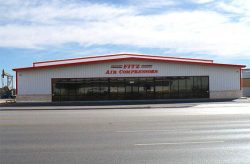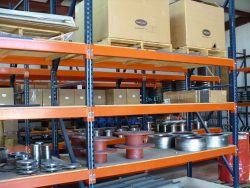Maximize Efficiency With Industrial Air Compressor Servicing
Industrial air compressor servicing is crucial to ensure optimal performance of your equipment, minimize downtime, and extend its lifespan. Efficient maintenance work also reduces costs, allowing you to avoid costly emergency repairs. In this guide, we’ll cover routine compressor maintenance, the parts that require servicing, and the difference between standard and preventive maintenance.
What is Compressor Maintenance?
Compressor maintenance involves regular inspection, cleaning, and servicing of industrial air compressors to ensure optimal performance. This process includes tasks such as lubrication, filter replacement, tightening bolts and connections, and monitoring temperature and pressure levels.
Scheduling regular compressor maintenance work benefits businesses by increasing operational efficiency, reducing downtime, lowering energy costs, and extending equipment lifespan. Further, checking your air compressor as scheduled enhances workplace safety and improves air quality. With preventive maintenance, you ensure compliance with industry regulations and reduce the environmental impact of your operations.
Standard vs. Preventive Air Compressor Maintenance
Some industrial air compressor servicing procedures are preventive, which are proactive measures to ensure the smooth operation of your machine. On the other hand, there are more routine servicing procedures involving basic upkeep.
- Standard Maintenance: Standard maintenance is a more general term and may not necessarily imply a proactive approach like preventive maintenance. These procedures help ensure that compressor equipment operates as intended. Standard maintenance could include basic upkeep tasks such as oil changes, filter replacement, and general cleaning. They may not encompass a comprehensive, planned preventive maintenance program.
- Preventive Maintenance: On the other hand, preventive maintenance is a more proactive approach to compressor equipment maintenance. The process aims to prevent issues before they occur. It can involve regularly scheduled tasks and inspections to keep equipment in good working condition. Preventive maintenance can include some of the processes in standard servicing. It will include other tasks like lubricating moving parts, monitoring and calibrating control systems, and cleaning heat exchangers. Preventive maintenance addresses potential issues before they lead to costly breakdowns.
Benefits of Preventive Industrial Air Compressor Servicing
Scheduling preventive maintenance for your air compressor systems boosts the productivity of your business operations. Consider the following benefits of having routine checks on your equipment:
Reduced Downtime
Preventive maintenance helps your team identify and address potential issues before issues with your equipment get worse. You also reduce the probability of experiencing unplanned downtimes. Your compressor remains operational for long, contributing to uninterrupted production schedules.
Preventive servicing and maintenance tasks keep the compressor operating at peak efficiency levels. It can lead to reduced energy consumption and operating costs while maintaining consistent equipment performance, improving productivity, and boosting returns on investment.
Extended Equipment Life
Scheduling preventive maintenance work can help prevent premature wear and tear on various compressor parts and components. You can address issues early and reduce the need for replacement parts.Improved Air Quality
Proper compressor unit maintenance involves changing air and oil filters while monitoring air quality and producing cleaner air. Further, it helps reduce the risk of contamination and damage to downstream equipment.
Cost Savings
By optimizing operational efficiency and preventing major breakdowns, you get significant cost savings over time. These savings come from reduced energy bills and fewer repairs.
Enhanced Safety
Well-maintained compressors are safer to operate. Preventive industrial air compressor service reduces the risk of accidents and injuries in the workplace.
Environmental Responsibility
Energy-efficient compressors contribute to a smaller carbon footprint, making your operations more environmentally responsible. You ensure that your equipment remains compliant with environment-related regulations through preventive and standard maintenance of your compressor systems.
Consistent Performance
Preventive maintenance ensures the compressor maintains consistent air pressure and flow, which is essential for high-quality product manufacturing processes.
Compliance with Regulations
In many industries, regulations and standards are in place to ensure the quality of compressed air and to improve equipment safety. Scheduling routine servicing helps ensure compliance with these requirements, which enables you to avoid fines and legal issues.
Improved Reliability
With regular maintenance, your employees can rely on your equipment to perform optimally, reducing operational disruptions and improving employee productivity.
Recommended Preventive Maintenance Checks
The following is a short checklist of compressor parts and features that require routine and preventive servicing.
- Air Filter: Regularly inspect and replace air filters to prevent clogs and maintain optimal airflow. Clean air filters ensure that the compressor operates efficiently.
- Oil Filter: Monitor and change oil filters as recommended by the manufacturer. A well-maintained oil filter is essential for the compressor’s lubrication system.
- Lubricant: Ensure that moving parts, such as motor bearings and pistons, are adequately lubricated with the manufacturer’s specified oil. Proper lubrication reduces friction and wear.
- Motor Bearings: Regularly inspect and lubricate motor bearings. Bearings are critical components that can wear out if not properly maintained.
- Belts: Check the condition and tension of the belts. Properly tensioned belts ensure power is efficiently transferred from the motor to the compressor.
- Intake Vents: Clean and inspect the intake vents to prevent obstructions. Restricted airflow can lead to overheating and reduced efficiency.
- Air Dryer: If your compressor has an air dryer, check its performance regularly. A well-functioning air dryer helps maintain compressed air quality and prevents moisture-related issues.
- Amperage: Monitor the compressor’s amperage during operation. Significant amperage deviations may indicate motor or electrical problems.
- Vibration: Regularly check for abnormal vibration. Excessive vibration can lead to equipment damage and should be addressed promptly.
- Temperature: Continuously monitor the compressor’s operating temperature. Sudden temperature spikes can indicate issues with cooling and demand immediate attention.
Servicing Different Air Compressor Types
Each variant of the air compressor will require a different type of service schedule. Maintenance intervals and parts servicing will vary daily to annually based on the manufacturer’s recommendations. The following are some general servicing tasks that can be scheduled based on the type of air compressor you’re working on.
- Air-Cooled Reciprocating Compressor: Perform daily checks and maintenance for oil or air leaks, worn belts, loose bolts, air filters, lubrication, heat exchangers, and intercoolers. Belt tensions should be checked every 160 hours. Change the lubricant and replace the filter every three months.
- Lubricant-Injected Rotary Compressor: Perform all routine daily checks mentioned earlier. Filters and cooler fins should be cleaned or replaced every four weeks. Inspect pressure relief valves and change fluid filters every six months.
- Lubricant-Free Rotary Screw Compressor: Aside from the daily servicing tasks mentioned above, you should check display readings, drain the condensate if necessary, and inspect the dew point on the integrated dryers. Inspect air inlet filters every three months and replace any damaged units.
Work with Authorized Compressor Parts Suppliers
If you need genuine compressor parts for your unit, Fitz Equipment is the brand to trust. We carry all major brands and hard-to-find components from various models, including Champion, Gardner Denver, Kaeser, Joy, and FS Curtis. Contact us today for more information and to get a quote.
Preventive servicing and maintenance tasks keep the compressor operating at peak efficiency levels. It can lead to reduced energy consumption and operating costs while maintaining consistent equipment performance, improving productivity, and boosting returns on investment.
Extended Equipment Life
Scheduling preventive maintenance work can help prevent premature wear and tear on various compressor parts and components. You can address issues early and reduce the need for replacement parts.Improved Air Quality
Proper compressor unit maintenance involves changing air and oil filters while monitoring air quality and producing cleaner air. Further, it helps reduce the risk of contamination and damage to downstream equipment.
Cost Savings
By optimizing operational efficiency and preventing major breakdowns, you get significant cost savings over time. These savings come from reduced energy bills and fewer repairs.
Enhanced Safety
Well-maintained compressors are safer to operate. Preventive industrial air compressor service reduces the risk of accidents and injuries in the workplace.
Environmental Responsibility
Energy-efficient compressors contribute to a smaller carbon footprint, making your operations more environmentally responsible. You ensure that your equipment remains compliant with environment-related regulations through preventive and standard maintenance of your compressor systems.
Consistent Performance
Preventive maintenance ensures the compressor maintains consistent air pressure and flow, which is essential for high-quality product manufacturing processes.
Compliance with Regulations
In many industries, regulations and standards are in place to ensure the quality of compressed air and to improve equipment safety. Scheduling routine servicing helps ensure compliance with these requirements, which enables you to avoid fines and legal issues.
Improved Reliability
With regular maintenance, your employees can rely on your equipment to perform optimally, reducing operational disruptions and improving employee productivity.
Recommended Preventive Maintenance Checks
The following is a short checklist of compressor parts and features that require routine and preventive servicing.
- Air Filter: Regularly inspect and replace air filters to prevent clogs and maintain optimal airflow. Clean air filters ensure that the compressor operates efficiently.
- Oil Filter: Monitor and change oil filters as recommended by the manufacturer. A well-maintained oil filter is essential for the compressor’s lubrication system.
- Lubricant: Ensure that moving parts, such as motor bearings and pistons, are adequately lubricated with the manufacturer’s specified oil. Proper lubrication reduces friction and wear.
- Motor Bearings: Regularly inspect and lubricate motor bearings. Bearings are critical components that can wear out if not properly maintained.
- Belts: Check the condition and tension of the belts. Properly tensioned belts ensure power is efficiently transferred from the motor to the compressor.
- Intake Vents: Clean and inspect the intake vents to prevent obstructions. Restricted airflow can lead to overheating and reduced efficiency.
- Air Dryer: If your compressor has an air dryer, check its performance regularly. A well-functioning air dryer helps maintain compressed air quality and prevents moisture-related issues.
- Amperage: Monitor the compressor’s amperage during operation. Significant amperage deviations may indicate motor or electrical problems.
- Vibration: Regularly check for abnormal vibration. Excessive vibration can lead to equipment damage and should be addressed promptly.
- Temperature: Continuously monitor the compressor’s operating temperature. Sudden temperature spikes can indicate issues with cooling and demand immediate attention.
Servicing Different Air Compressor Types
Each variant of the air compressor will require a different type of service schedule. Maintenance intervals and parts servicing will vary daily to annually based on the manufacturer’s recommendations. The following are some general servicing tasks that can be scheduled based on the type of air compressor you’re working on.
- Air-Cooled Reciprocating Compressor: Perform daily checks and maintenance for oil or air leaks, worn belts, loose bolts, air filters, lubrication, heat exchangers, and intercoolers. Belt tensions should be checked every 160 hours. Change the lubricant and replace the filter every three months.
- Lubricant-Injected Rotary Compressor: Perform all routine daily checks mentioned earlier. Filters and cooler fins should be cleaned or replaced every four weeks. Inspect pressure relief valves and change fluid filters every six months.
- Lubricant-Free Rotary Screw Compressor: Aside from the daily servicing tasks mentioned above, you should check display readings, drain the condensate if necessary, and inspect the dew point on the integrated dryers. Inspect air inlet filters every three months and replace any damaged units.




